Cold weather clothing for people who bike

Winter weather bike clothes from Riyoko.ca
A few months ago, Kristi Woo of Canadian bike fashion label Riyoko, reached out to me to do a guest post on cold weather clothing for people who bike. As a resident of California, I jumped at the chance to get advice from an expert winter cyclist. Unfortunately for Kristi, I had just had a baby and it took me months and months to post her fantastic guide. Even though the calendar tells us it’s spring, Winter Storm Ursula has the North East US (and South East Canada!) all chilled out, so you still get a chance to try out her tips. Enjoy! --Melissa
Although I’m a daily rider, it took me a while to start biking through our chilly Toronto winters. Like many cyclists, put away my beloved bike for the season. For those few months, it was agony not being able to get from place to place with the freedom and ease of a bicycle.
And to be honest, it took me a couple weeks to remember how to function without bike access. When spring would finally roll around again, I had to face the pain of my leg muscles. It would take about week for my muscles to relax back into riding.

In the fall of 2001 my boyfriend's sister gave me a mountain bike that she had won in a draw, so I started winter cycling. The next day, I rode through ankle-high fresh snow all the way to work. It was just as wonderful as riding a bike at any other time of year! Although there was an adjustment period as I got used to navigating snow.
From that day forward, I've ridden all year round. I don't remember exactly what I was wearing back then, but I do remember, just as with my Spring and summer wardrobe, I experimented with different pieces until I found what worked best for me.

Winter weather is cold, windy, sometimes wet and slushy, not to mention messy. By using layers, you can build a pretty reliable uniform of cold weather clothing that will work in various winter climates.
My winter wardrobe go-to’s are breathability, moisture wicking, and loft and insulation on the inside. On the outside, wind resistance, water resistance, and stain resistance are key. Items should be easy to layer and easy to pack.
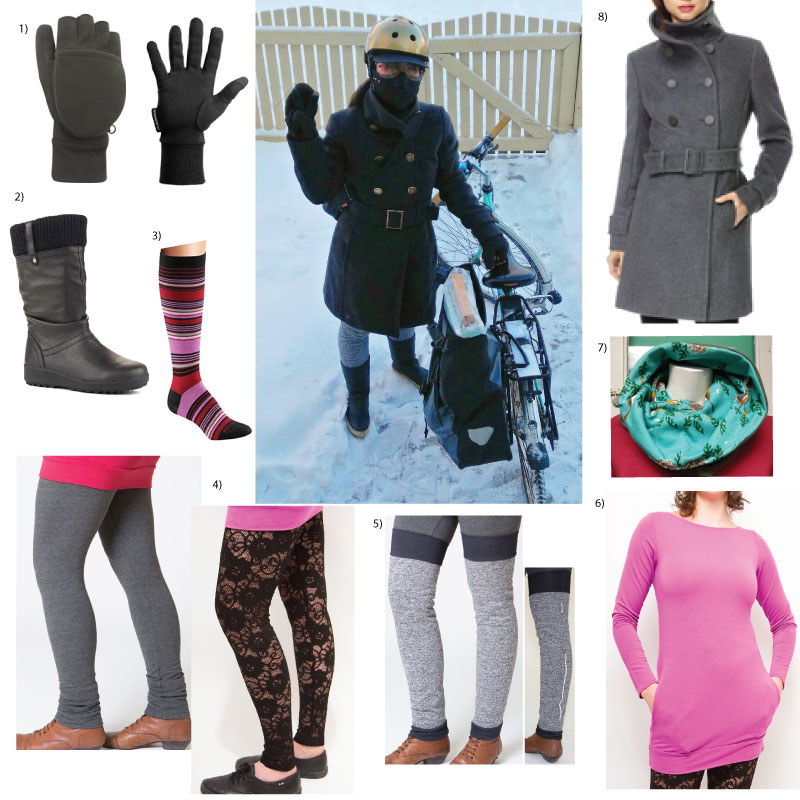
-
Double up on mitts: Gloves don't cut it, so my tried and true method is to wear merino wool glove liners, and polar-tec mitts/fingerless gloves. My digits stay warmer together during the ride. Once I’ve stopped, I can shed the outer layer and have the freedom to use all five fingers to open my bag or lock up my bike
-
The right boots: Good thick soles keep the cold away. Traction on icy streets is a must. An insulated lining is also key: Thinsulate, or sheep skin linings for the best warmth factor. Lastly, I prefer leather outers because they look fancier – pre-weather proofed is best, but if they aren't I make sure to weather proof them myself. And don't forget to make sure there is enough room for socks when you are trying them on! If I need fancier foot fare at my destination, I just pack my indoor shoes in my bag.
-
Smart wool socks keep feet insulated, and dry with less itch factor than traditional wool sock. They’re less bulky. My favorite brand is Fox River. They last the longest, and are very comfortable with great patterns to choose from. Knee length socks keep my legs warmer under my Tights.
-
Riyoko Bamboo Fleece Tights layered with Tights, or Lace Tights. I specialize urban travel. In fact, I make bike clothes for a living. And I absolutely wear all my own clothing because I’ve designed it to be functional and chic. The Bamboo Fleece Tights keep my legs insulated, wick away sweat, last forever, and are super comfortable and stain resistant. For wind resistance, I often layer them with Riyoko Tights. For a fancier look, I will layer my Bamboo or regular Tights with the durable Lace Tights.
-
ReFleks Water & Wind Resistant Wool Leg Warmers with reflective details. Commuting by bike in the winter means that I leave the studio when the sun is on the way down. To keep the chill out, I layer a pair of leg warmers on top of my Tights. When it's wet or windy, they keep my legs warm and dry. Easy to pack and easy to put on and take off, they have a retro-reflective strip on the back of the leg for extra visibility at night. I also like that they resist and hide stains.
-
Merino Wool, or Bamboo layer. I usually wear a base layer, and then a light sweater layered on top which I can pack away in my bag if the weather is warmer. I prefer Merino, Bamboo terry, or fleece for my next-to-skin and mid layers because they insulate for warmth, but manage sweat effectively and are odor resistant.In cold temperatures, it is important to keep moisture away from your skin. Fabrics that wick, provide loft (like fleece or terry), and clothes that are a a little looser than skin-tight let moisture move away from the skin, allow air to circulate, and also keeps drier, warm air next to the body.
-
Travel hood. Made from merino wool and organic cotton, it's a scarf and an a hood at the same time. It fits under my helmet, and also cinches up to cover my face when the wind is biting. It keeps the wind out at the neck, and it's surprising how that alone can keep me warm!
-
Babaton Melton Wool Coat. I had no idea, but this coat is a classic at Aritzia. I lucked out and bought it off a friend who was moving overseas, but I looked online recently while I've been writing this mini guide, and saw it in a few places for a pretty fair price!
Tightly woven wool is great for wind resistance, and water resistance. And Melton wool is the best. It is traditionally used for military grade coats. If you are looking at getting a wool coat for cycling and winter in general, look for wool coats with an inner insulating lining (moleskin, or something other than the 70s polyester fluffy stuff) between the woolen outer layer, and the inner silky lining.
Traditionally many coats had this, but nowadays, many coats skip out on it. It makes a difference in insulation, and wind resistance. I also look for coats that have a roomier back so I can reach my handle bars in comfort, and so I still have room for air circulation in the back. I also find the length is important. Most often the thigh area above the knee is exposed and can make you cold. Having a jacket/ coat that covers that area can help keep you warm.
This coat is also wonderful because it has a high collar. I have a water and windproof shell as well, but sometimes, you just can't beat having a beautiful wool coat to take you from your bike to work, and then to the theatre. Especially when you go from riding to being more stationary outside, the wool will keep you consistently warm, whereas the shell is great for cutting the wind while cycling, but it doesn't do much for warmth once you've slowed down.

-
Ear Muffs – keep the wind out and keep my ears warm. They are great for warmer days when you don't need a hat, and they fit well under my helmet in the ear wells when I wear one.
-
Seirus face mask or travel hood - These two pieces keep my face warm and cut the wind. The travel hood acts like a scarf and then a hood when it gets colder, and I can wear it as an accessory with most of my outfits. Before I made the travel hood, and on super sub zero days I opt(ed) for the Seirus face mask. Masks like the serius mask are easy to find in most sports or outdoor shops. I also like these pieces because they both
-
Nutcase Gold Sparkle helmet - This is my favorite helmet. It's higher visibility, and stylish, and it fits a variety of hoods and hats underneath it, and it has good ventilation.
-
Hat with optional ear flaps, I got this hat from my father because he liked his so much he boutght one for me. It's basically a hunting cap lined with polar fleece lining, ear flaps, and an area I can pull a pony tail through. This particular one fits nicely under my helmet in very cold weather. And, I was surprised how much a visor can help keep the wind and sleet out of your eyes on blustery days.
-
Sunglasses are great for the usual things sunglasses are for, but also for wind and rain. However, when it gets really cold, or it's snowing heavily, or blowing sleet ski goggles might work better.
-
Ski goggles - I recently bought anti-fog ski goggles. I haven't had a chance to use them yet, but I think these will be great for really cold days, as they will cover my whole face beyond the face mask. Can't wait to try them out!

Tires
I started winter cycling on mountain bikes with knobby tires. It seemed in Toronto that was all I needed for the slush and wet snow. When I got back to Calgary, there was much more ice, and eventually, I switched out the knobby tires for studded tires. The studded tires I looked at this year ranged from $60-$120 per tire depending on the kind of bike one has, and how universal the tire size is for the bike.
If ice is not such an issue where you are, but snow is, 'knobby' tires could suffice. Knobby tires have deeper treads to interface with slippery, icy, or slushy surfaces. I did learn one unfortunate thing this winter: there are no studded tires for vintage bikes that use the 26 1/4 sized tire, so, sadly, for all of us vintage loving cruiser types, 70s cruisers are usually not able to be kitted out with studded tires.

Bike maintenance
I have to admit, my version of bike maintenance has been pretty low in winter months past. I let a couple bikes rust pretty thoroughly by biking through the salty snow and never wiping them down – and I then I finally started to learn how to maintain them better. I try to get my bike tuned up before the snow flies, and I am consistent with wiping down the chain and the derailleurs, and oiling them to prevent rust.
For winter there are special lubes that you can use that are more tacky and prevent rust. I like using Tri-flow Superior Lubricant. You can get it at most any outdoor gear/ bike shop. Occasionally, I wipe down the frame, fenders, and the wheels after slushy rides. And, on warmer days, I take some warm water in a dish soap bottle and spray it down – especially the chain, and the derailleurs.
The chain and the derailleurs are the most likely to rust over the course of a winter, due to exposure and road salt. On my most recent winter bike, I also have an internal gear hub, so that cuts down on my maintenance a bit.
How to bike in the winter
Like putting snow tires on your car, or having the proper layers to go hiking or for a run, biking in the winter takes just a couple simple things:
-
Check the weather.
-
Get your clothes ready the night before, and dress in layers that work for you.
-
Know your route. Choose one that is safe and comfortable for you. In the winter, in many cities, just like for cars, you can check road reports to see the conditions of pedestrian/ cyclist routes. And if not, contact your local Bike coalitions and get them going on it.
-
Pack a couple extras, mitts, leg warmers, a hat and extra lights.
-
Keep your bike maintained, and ready for snow.
-
Even on the colder days, make yourself get out there, it will be worth it!
Once those pieces are in place, biking in winter is inspirational. You get to see your surroundings through the transitions of the seasons. For me, the Bow River is what I look forward to. I love seeing the changes of the seasons, especially the freezing and thawing of the river, and the colours. Riding in any season gives me time to think on my commute, but I find it the most peaceful in the winter.

Feel free to email me at info@riyoko.ca with your winter cycling photos or any questions this article might leave you with. And give riyoko_ca a follow on Instagram to see more photos of my commute along the Bow, and what I am up to in the studio. To your winter journeys on two wheels!

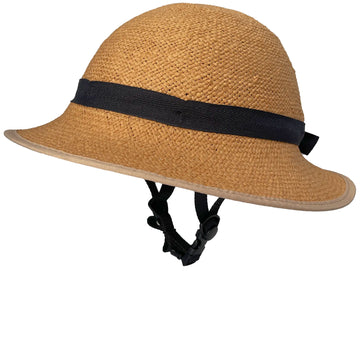
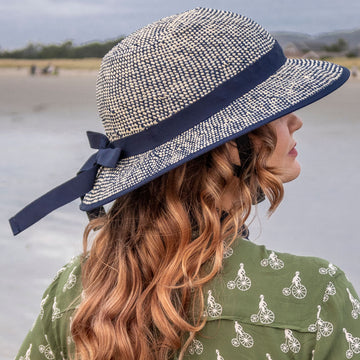

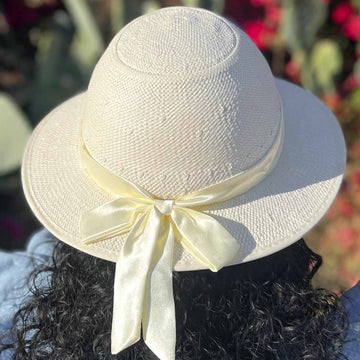


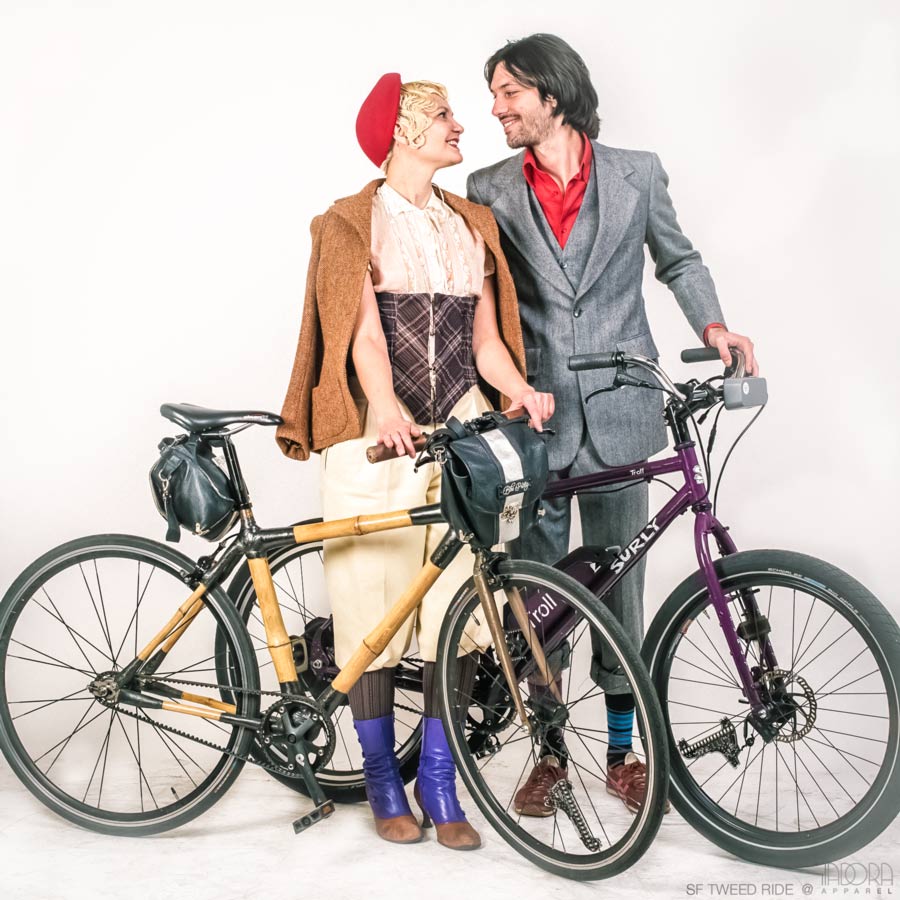




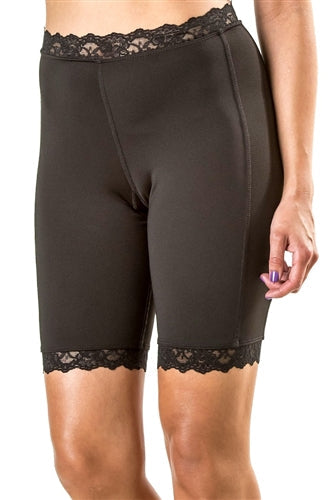

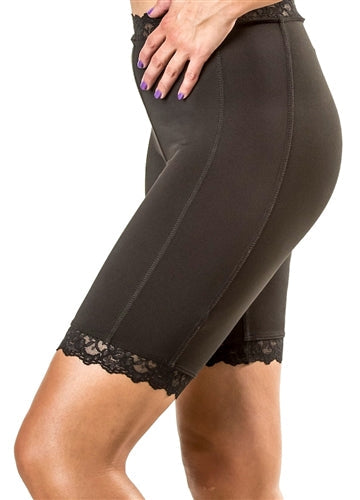
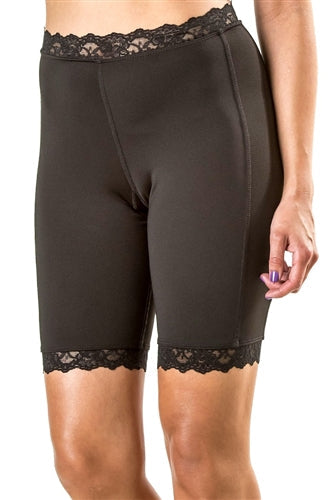

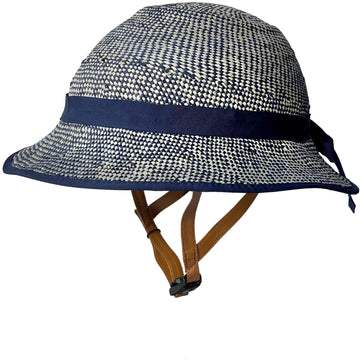

Will you be carrying the straw helmet in xl any time soon?